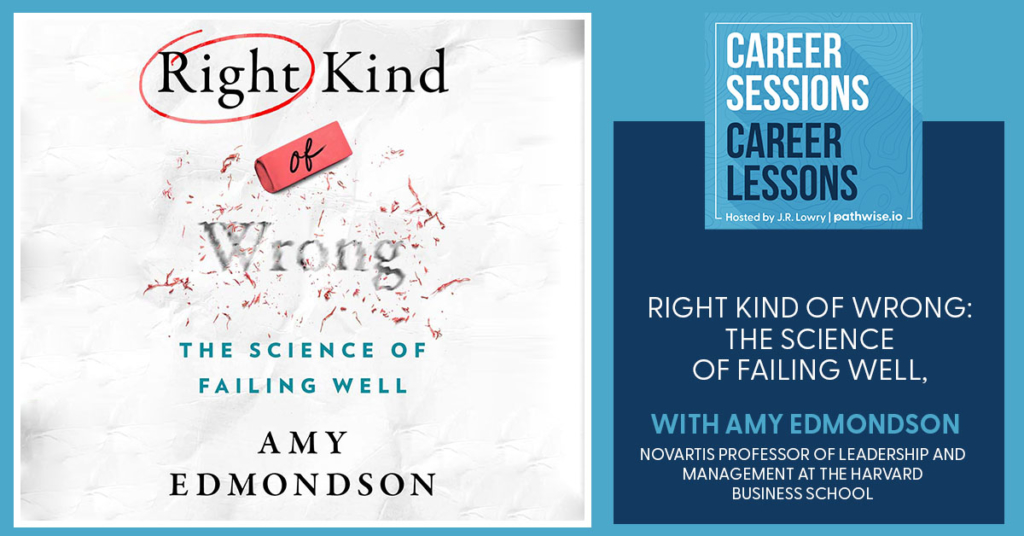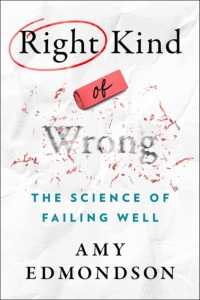
Right Kind Of Wrong: The Science Of Failing Well, With Amy Edmondson
Not all failures are alike. Although they are disappointing most of the time, there is gold to be found in failing well. In this episode, J.R. Lowry sits down with Amy Edmondson, Novartis Professor of Leadership and Management at Harvard Business School, and author of Right Kind Of Wrong. Together, they discuss the self-development benefits of building a good relationship with failure, how to maximize learning from your intelligent failures, and how the most complex failures can be prevented simply by speaking up. Amy also talks about her strategy to keep a consistent writing process, what it is like to watch corporate teams work, and how the Thinkers50 community fuels her unique thinking.
Watch the episode here
Listen to the podcast here
Right Kind Of Wrong: The Science Of Failing Well, With Amy Edmondson
Novartis Professor Of Leadership And Management At The Harvard Business School
I’m very pleased to welcome Amy Edmondson. Amy is a leadership team and organizational learning scholar and is the Novartis Professor of Leadership and Management at Harvard Business School. She has written 7 books and over 75 articles on the dynamic forms of collaboration needed in environments that are characterized by uncertainty and ambiguity. She is best known for her pioneering work on psychological safety.
Amy earned a PhD in Organizational Behavior, a Master’s Degree in Psychology, and a Bachelor’s Degree in Engineering and Design from Harvard University. Before working at Harvard, she was a Director of Research at Pecos River Learning Centers. She was also the Chief Engineer for Architect and Inventor Buckminster Fuller. In 2019, Amy was selected the Most Influential Thinker in Human Resources by HR Magazine and is ranked number one on the Thinkers50 list. Amy, welcome. I appreciate you doing the show with me.
Thanks for having me.
Let’s start with a book. You’ve got a new book coming out soon, Right Kind of Wrong. Can you give us a bit of an overview of it?
It’s a guide to the failure landscape. The core idea is that not all failures are alike. You’re familiar with the phrases fail fast, fail well. My argument is those make sense in some contexts but not all and for some failures but not all failures.
The book builds on the research you’ve done on psychological safety. The work that builds your career around but what was the specific catalyst for writing a book on failure?
The specific catalyst, in terms of this time, for me, is coming back full circle because I discovered psychological safety or I got interested in psychological safety by studying failures. I didn’t set out to discover, but what I found along the way was that people had remarkably different tolerance for speaking up about failures and errors in different groups, even within the same organizational context.
That was something that struck me as interesting and important, particularly for the goal of learning. That’s how psychological safety came into my life and became a core research interest in the area. Failure was always lurking in the background because failure is part and parcel of being alive. I’ve always been fascinated by it. Failure is part of a full life. It’s certainly part of any innovative company that succeeds over the long term, but the concept of failure has been widely misunderstood.
Many people are ashamed or afraid of failing. Why is that? What do they lose by not having a better relationship with failure?
We’re naturally ashamed of our inadequacies or shortcomings. We want to be seen as perfect. We want to be seen in a good light by others. This is quite instinctive as well as learned through life because there’s this underlying worry that will get rejected. If we get rejected by the group, the company, or the family, we will be in trouble. The irony is that we want to be seen as perfect but we don’t like people who are perfect or who seem to think they’re perfect because, deep down, we understand that’s not real. We want to be seen as flawless, and it’s a fundamental error.
At the same time, you talked about failing fast and the flaws and failing fast in certain domains. I know you feel equally about the idea that failure is not an option. At the same time, you bring up early in the book the point that accepting failure doesn’t mean accepting mediocrity.
It’s a very important point. If you limit truly embracing failure to what I’ll call the good kind or intelligent failures, then the logic of embracing failure and even the fail fast, fail smart logic makes more sense. It’s the opposite of mediocrity because in order to experience intelligent failures, you have to be willing and able to engage in smart experiments.
In order to experience intelligent failures, you have to be willing and able to engage in smart experiments. Share on XYou have to do your homework. You have to think clearly about what might be possible. View what’s known and what’s not known, then you’re taking this smart risk. You’re trying something new, which is an ambitious and brave thing to do to see what happens. You hope it succeeds but it won’t often because you’re in new territory and you didn’t have a crystal ball.
The kinds of failures that happened because you mailed it in, you didn’t read the instructions, or you broke a rule are the kinds of failures that happen because of a willingness to embrace mediocrity. It starts with being very clear about the difference between intelligent failures and other kinds of failures, then committing to doing what you can. We can talk more about this to prevent preventable failures and admit to embracing and setting out to experience more of the good kind.
You brace that point early in the book. Certainly, that was one of the things that stood out for me in reading. There is an intelligent failure, and then there are all the other failures. You want to ultimately tilt the scales more toward having some of that intelligent failure. As a leader, it’s hard trying to create an environment where you want people to report all kinds of failures, including the ones that you would ultimately deem as not intelligent. You’ve got to create that environment for, again, allowing people to feel safe doing that but also helping them to start to distinguish between, “Was that a good failure, an intelligent failure, or not an intelligent failure?” Going back to your work on psychological safety, how you can do that as a leader?
There’s so much to say about this. One of the things that I want to say is that don’t be afraid to describe the bind. Don’t be afraid to say out loud that, on the one hand, you want creativity and innovation. On the other hand, we worry about doing things well and make the tension at the heart of this issue discussable because it’s fundamentally a team problem-solving opportunity.
It’s not something that you, as a leader, either should or could specify to others what to do and how to do it. Nonetheless, what are the key things that leaders can do? To me, it starts with messaging and being crystal clear that you see the uncertainty and the challenge that lies ahead. When you describe those attributes, you’re issuing an implicit invitation to others to contribute, to be the eyes and ears of the organization, to contribute their ideas, and to speak up quickly about concerns or signals of a possible threat.
You’re saying, “We don’t have a perfect playbook. We cannot because of the world in which we operate.” That messaging, I believe, is at the very heart of it. This is where it starts. It’s sending the message that you see an uncertain challenge and you’re excited about it. You’re optimistic that working together with all of the skills, experiences, and talent we have here, we can do great things, but it’s that straightforward.
You’re not mistaking your plans for something that is written in stone and will necessarily happen. You are presenting, thinking of, and messaging plans as good hypotheses but ones that will invariably need to be updated as more is learned. It starts with messaging. At the very top of organizations, it’s about building systems and support for smart experiments. One thing I always want to emphasize at the top of organizations is that your pilot projects of innovations of new services and new products should fail.
Now, I don’t mean in an absolute sense being useless. I mean that they should discover. They are good pilots if they have discovered the vulnerabilities in your great new idea before you release it at scale. What I often see in organizations is a picture-perfect pilot, only to be followed by a launch that is a fiasco. They didn’t get the kinks out. They didn’t realize that the pilot was a failure because it didn’t fail. Whereas, the launch was a failure because it did fail. In other words, senior leaders are those who helped create the conditions and the spaces where the failures happen so that they don’t have to happen publicly and at scale.

Failing Well: Pilot projects and new services should fail. They should reveal the vulnerabilities of your great ideas before you release them at scale.
In the scheme of things, getting it right the first time is not always a blessing. It’s not always what you want because learning about the things that don’t work helps you sharpen the direction in terms of what will work best. Sometimes, even in those pilot efforts, we get overly hooked on the idea that the pilot has to go perfectly for us to consider scaling it. Sometimes, you need a pilot not to be perfect and you should still be willing to go forward with scaling it based on what you’ve learned.
You think of the pilot as a proof of concept rather than as a laboratory experiment to figure out because it’s a good idea. Let’s say we wouldn’t be doing it if it weren’t a good idea. Your job now is to figure out how it can work perfectly at scale later. Not right this minute. The only way to have it work perfectly at scale later is if now, it’s willing to fail and fail small in the right way.
Flipping to the other side more of the bad failure types, you distinguish between basic failures like I forgot to brush my teeth one morning. The complex failures you describe are the example of the oil tanker that got grounded off the Isles of Scilly, Southwestern England. By the way, that was the second time in a month I’ve heard of the Isles of Scilly. I’ve never heard of them other than that. It was a weird coincidence. It’s a remote place and a guy that I typed with was born on the Isles of Scilly.
That’s a magnificent and tragic example of a complex failure. Let me know the two kinds. Neither of these two types of failures is good. They’re not things to be celebrated. In fact, whenever possible, which is most of the time, we try to prevent the two kinds of bad failures. A kind 1 is a basic failure and a kind 2 is a complex failure. Basic failure is a single-cause failure. A single error leads to a failure. It could be a big failure or a small failure.
For example, I write about this in the book. A New York City bus driver, a couple of years ago, crashed into a Brooklyn brownstone. Sixteen passengers were injured. None of them were seriously injured, fortunately, but the bus lost the route and did a lot of damage to the buildings as well. What was the cause? The driver had put shopping bags between his feet, which ended up leading his foot to get stuck in the accelerator.
You could say that’s a weird thing out of the blue. There were explicit rules about nothing between your feet. Nothing in front of the driver’s seat was allowed. It’s an error. It’s a rule broken and without bad weather and no other factors whatsoever, it led to this semi-tragic failure. Whereas the Torrey Canyon, the oil tanker that crashed in 1972 near the Isle of Scilly, was one of the worst environmental disasters in history.
It was not a single. The captain lost control and crashed into a rock. Indeed, my analysis of the story identifies at least six different factors. None of which on its own would have led to this tragic failure but, in a sense, they all had to line up. It’s what we think of as the perfect storm. The factors coming together, exacerbating each other led to the failure.
As a leader, at a minimum, you want to try and nip these things in the bud when they’re smaller, more basic failures and not let them snowball into bigger things.
When I say factors, the six factors in this case are all small deviations from best that, on their own, would not lead to a bad outcome. You can casually ignore them or not worry too much about them. We didn’t program it right. Anyway, the currents changed in a way we didn’t expect. All of those things would have been totally fine but having the fact of them all happening at once led to the outcome. Most of the complex failures I’ve studied could have been prevented had someone been willing to speak up or felt able to speak up early in the process. That’s where psychological safety comes back into the story. If any one of these factors were caught and altered in time, then we wouldn’t have the complex failure.
Most complex failures can be prevented if someone is willing to speak up early in the process. Share on XYou see that so much. You talk a lot in the book about the healthcare industry, airline travel, and the way that pilots interact with each other. I don’t know whether you are the catalyst for some of the changes that did go on in the airline industry but there were a couple of very famous examples. There was the Korean Air crash out in California where the copilot felt afraid to speak up. There was one in New York where the copilot was afraid to speak up. You hear all the time about nurses being afraid to speak up. It makes such a huge difference when you can create an environment where people know that they can.
It was well before my time in terms of my professional career interest in this topic. It was a culture change in aviation and passenger air travel across the board. That occurred because of the black box analysis that led to the recognition that way too many of these tragic failures were, in fact, traced back to a copilot, a lower-in-the-hierarchy person being willing to speak up to contradict a pilot’s order or observation. Once you saw it as a pattern, it was impossible not to say, “What do we do about it?” They introduced training and awareness that changed the game entirely and has led to such an extraordinary safety record now.
Now, decades later, healthcare delivery started to wake up to the same idea. It took longer because the tragic failures that did happen in that context, let’s say, especially in the context of hospitalized patients happened one at a time. You don’t wake up and see the headlines of the newspaper about 200 deaths due to some catastrophic medical error. It’s one at a time. It took longer to realize that some of the same human interpersonal dynamics were at play here, and the culture also needed to shift to one of anyone at any level being able and willing to speak up directly with a question or with concern.
Including the patient. I think about going in for hip surgery years ago and the doctor, before I went into the operating room, said, “Sign the leg I’m operating on.” That way, there was no mistake.
That’s a beautiful example of an error-proofing technique. It sounds silly but it is smart practice. Why take the risk? As much as I’m appreciative of intelligent failures in new territory, I am aghast at preventable failures in familiar territory. If we know which knee, and we do, needs operating and a surgeon goes in there and operates on the wrong one, that’s unacceptable. We don’t need to have that. There are simple procedures we can use to prevent that failure from happening.
As individuals, we’ve talked a little bit about some of the things that organizations can do. There are a lot of ways that our brains work against us in terms of preventing, assessing, and responding. You talk about a fair amount about that in the book. Maybe you can give a little bit of what are the barriers that get in our way of handling these situations better?
There are so many but the ones that come to mind other than the spontaneous aversion to failure that desire to look good, which is very natural and reinforced in our society and our upbringings. A fun one is the confirmation bias. Most people are familiar with the idea of a confirmation bias. It can lead us to miss evidence of failure, lead us to miss that we are doing the wrong thing or drive in the wrong direction.
We were looking for the data that reinforced our existing hypothesis about what we’re doing. We can tune out the data that disconfirmed our idea about what we’re doing. That’s an important one right there. If we are not seeing some of the failures that were part of and contributing to, it’s pretty hard to learn from them.
There is a widely held belief by many. It’s not right but you learn more from your successes than your failures. That’s why that’s doing it wrong, so all I can learn is how to do it wrong, rather than, in fact, there’s a lot of gold there for how you might change and do right and we worry about what others think of us as well.
What can we do to counteract those things and help ourselves learn as much as possible from failure?
First, we have to remind ourselves that our job here on planet Earth is to keep learning. That’s why we’re here. That’s why we’re giving these big brains to keep on learning in an ever-changing world. Part of that learning will be missteps. Particularly, we hope, the missteps going forward. Be willing to go through. I’m not going to say it’s hard work but it can be emotionally hard work of learning from our failures.
The simple process there is to start with the clean question of what happened. Our instinct is, “Who did it? Who’s to blame here? How did I screw up?” rather than just, “What happened?” Once we’ve described in our minds what happened as best we can, “What did I do or not do that contributed to that happening? What will I try to do differently next time?” That simple.
Simple but hard. Switching gears, I always like to ask authors about their writing process. What’s yours?
My writing process is remarkably inconsistent. I don’t have a particular time of day. I do it when I can. I squeeze in wherever and whenever I can. I will say that one process I seem to be stuck with is that whenever I’m writing something, let’s say it’s a book, which always means you’re writing a chapter at any given time. I’m working on a piece of a book or an article. I open the file on my computer and there I am, like it or not, at the beginning.
Part of my process, which I’m not sure is best practice, is to take a close hard look at that beginning once again and see its flaws. I will sit there and try to make it better almost endlessly. At a certain point, I have to kick myself and say, “Time to move on. You got to go on to page two now.” If you look closely at many of my books and articles, you will find that they start strong.
You clearly put a lot of thought into the beginning. Mostly, your chapters in this book start with a story. There are a lot of stories in the book. Storytelling is something that’s such a powerful tool for authors. You use it pretty frequently and very well.
Thank you. It’s something I’ve learned how to do.
Do you feel like you’re writing has gotten better? You’ve done 7 books and done like 75 articles. How has your writing process evolved over the years?
I’ll tell you what’s the same. What’s the same is the endless drafts. Now that it’s all on a keyboard, you don’t count pages that you’ve thrown out anymore, but there’s no question that by the time you see a paper or a book, way more sentences and words have been tossed than kept. It’s a willingness. Any good piece of writing is about taking away that which was not good rather than being a good writer. I don’t think there’s any such thing.

Failing Well: Any good piece of writing is about taking away that which was not good rather than being a good writer.
Although, I do think that writing reflects thinking. The challenge of writing is getting clear on, “What do I think? Do I have the other evidence of that?” It’s this iterative process. What’s different for me is that I have more skill born of experience. What’s different is that I have more comfort with bringing out my own voice. I look at my early writings. I’m not in there. In this book, I show up now and then.
You show up right at the beginning.
Periodically, I’m there on the ski slope with one of my kids and later, worrying about another one taking a summer job that I don’t think is going to go well. It’s not all. Clearly, it’s not all about me at all, but I’m more willing to bring my own voice into it.
How do you continue to come up with fresh ideas?
It’s a mix of reading, talking with people, and visiting organizations. It’s never anything brand new under the sun but there are all these remarkable connections between things that can only occur and then give rise to new ideas from going out there, being observant, and trying to make those connections.
Certainly, we all continue to learn and evolve. New things strike us that we hadn’t necessarily thought about before. It’s hard sometimes. I would imagine there are times, especially as you become known for writing regularly, there’s always that pressure to produce. That has to be hard at times.
Especially when I finish a book, I think every time, “Never again,” then lo and behold, there you are doing it again. That is partly that pressure too what have you said lately. In a way, it’s what I what I do. I want to explain things so that I can convey to others what I’ve learned in this wonderfully circuitous path.
Given that this is a career-focused show, we would be remiss if we didn’t bring failure into play in terms of talking about how it plays out in our careers. How do you see it playing out in the way that people think about their careers, both the good and the bad?
Let me start with the bad because the bad, which I see so much of among my students, is such an easy trap to fall into, which is not taking risks. It’s picking the thing that seems safer. A related phenomenon is picking jobs for some small pay discrepancy rather than for a big learning discrepancy, especially when you’re very young, early in your career. Always go for the job from which you will learn more which often means you’ll be stretched or maybe it’s a different context, out of your comfort zone in other words. Make sure to mind those lessons. Do not pick, again, especially early in your career, jobs based on pay.
Also, based on what somebody else wants you to do or what conventional wisdom thinks you should do. You teach business school students who probably feel that they should go off to consulting or investment banking. For many of them, that’s not the right choice.
It’s true. It’s funny. They come to us to learn how to be great managers and they often go off and don’t manage. A generation ago, it was quite different but they don’t put quite enough value on the joy and the contribution from being in an operative company that is producing products or services upon which our society depends. The excitement of being part of something large and complex, that is doing something that none of us could do alone and doing that through leading and managing people. It’s quite a satisfying opportunity if you think about it.
If you can get effective at helping people embrace change and failure, learn from those, and continue to make the organizations better, that’s ultimately the essence of leadership in a way.
On the good side, the good part of the way failure can play out in managing a career is related to being willing to take on challenges, knowing it will be a stretch and it won’t necessarily go perfectly, persistence, grit, and a very strong and disciplined habit of reflecting on your own experiences. Doing everything you can to mine the lessons that your experience is offering to you but you won’t get it automatically. You have to pause to reflect. You have to be willing to think deeply about what has worked, what hasn’t worked, where you’ve done well, and come up short. That’s got to be part of your habitual approach to work.
Many people look at those situations that they did not enjoy. They didn’t do well at it, didn’t like the people they worked with, or didn’t like their boss. They’ll put that in a bucket of failure in a way and they’ll completely move on and almost mentally and emotionally cut ties with it. Some of that is probably necessary but at the same time, you’re missing that learning opportunity if you don’t think about both the good and the bad, the successes and the failures, the things that worked and didn’t work in your past, and what you did every day in your past jobs, all of it.
You become more at risk of playing not to lose rather than playing to win. Taking the safe bets and only entering the contest you know you can win which is a loss.
Maybe we’ll bring that into your own career. You have a triple degree from Harvard. When you were a child, what ideas did you have about what you wanted to do professionally?
I don’t remember having very clear ideas. The only thing I remember is thinking I could be a teacher. I had an early affection for explaining things, maybe as an older sister. As a child, that’s one of the jobs you see. I did periodically think about being a teacher but I didn’t spend an awful lot of time or clarity about what I would be, which you could have saved me some time if I had.
Most of us are in that case. I can’t even remember. At one point, I can remember wanting to be a lawyer. That lasted about 6 months when I was maybe 12, but other than that, I can’t remember anything in particular. You ended up spending some time right after Harvard undergrad working for Buckminster Fuller. How did you land that job? What was it like working for him?
I heard him give it a talk while I was in college and I was mesmerized by his message, which was that, “We’re here to make a difference. We’re on spaceship Earth to use our brains to solve problems and take care of each other and the future.” I said, “That sounds good to me.” A bit encompassing but I was quite impressed by his message. He was a remarkable inventor, educator, and writer. I decided to take a huge chance.
The stamp costs $0.13 to write a letter. Technically, I asked for advice, “I’m about to graduate from college. I wonder what advice you might have about somebody with this particular technical degree but who has a real interest in contributing to things that matter?” To my utter surprise and delight, he wrote right back and said, “When you finish up with Harvard, why don’t you come and join me in my Philadelphia office?”
If you think about it, that sentence doesn’t tell you very much. What does that mean? What would I get paid? What would I do? It didn’t matter. I decided I was going to show up. There was never anything. I wrote back and didn’t hear again about the start date or anything like that. I showed up. That was scary because here I was, in a city I’d never been in before. I showed up, essentially knocking on the office door and it was amazing and fantastic. Pretty soon, within a pretty short time, I was knee-deep in engineering projects that were ongoing. It was a dream come true.
How did that experience shape how you thought about your career since then?
It’s shaped who I was in some very profound ways, in part because being in the vicinity of someone who himself was such a risk taker and hadn’t followed the beaten path but had been creative and done such a variety of things legitimized that expansiveness. He was widely admired and had a successful career in life with many admirers, and friends. It allowed the weird to seem okay because this was all a little strange to go build your geodesic domes in strange parts of the world.
Working for him, he was generous with praise and appreciative. He was a joyful human being who celebrated other people and life. It’s spoiled me. That was my first post-college job. How do you top that, working right at the top, right for the boss as it were? He gives me opportunities to do things I’ve never done before. I was terrified the first time he said, “Could you do engineering drawings for these projects?”
I thought, “Now I’m going to get caught.” Come up short but he thought they were fine on and on it went. Lots of risk-taking, opportunity, and wonderful feeling in the office of being part of a family that was making some difference. He talked a lot, by the way, about failure and mistakes as key sources of learning. He talked a lot about the various failures he’d had both personally and technical engineering failures. He exudes a joyful, almost childlike energy about what he learned from each of them and how they shape the overall journey. I thought that was a very inspiring message. I must have parked it away in here somewhere.
You’ve come full circle as you said early in the discussion. You spent some time after at Pecos River Learning Centers. You were among other things, I’m sure, watching corporate teams come in and go through these outdoor learning exercises. Watching them, what did you learn?
This is where my psychology training, informal began because I was watching people. Instead of doing geodesic calculations, I was watching people. One of the things that jumped out at me was how people in these outdoor training exercises, which were quite challenging. They’re safe but they’re emotionally challenging. They feel frightening like climbing a pole or jumping off a zip line.
I saw that people developed very strong commitments to their groups which were usually in tech teams from companies. Powerfully and quickly when they had an opportunity to be vulnerable and authentic with each other in this weird non-work setting when they were putting a position of physical challenge that required, they found themselves quite dependent on each other for support to take these challenges.
They bonded in ways that were quite striking and you’d hear them talking about, “If we could take this energy back there, we’d be awesome.” In in that story, you can hear so much of my later work. It’s about psychological safety, being honest, being vulnerable, and ultimately, problem-solving and realizing that as teams, they could do more than they thought they could do.

Failing Well: If teams are honest and vulnerable, they can do more than they thought they could do.
We had one big project in my job and the culmination of that after several years. It’s the trial-by-fire thing. That creates a bond that you don’t get in the day-to-day. You wonder, “How could you create that without having to have the fire?”
Sometimes sports teams, and usually earlier in people’s academic lives, have some of that same going through something stressful, challenging, and uncertain with each other, and that tremendous bond can happen.
You’re also involved in Thinkers50. For those of you who are in the Thinkers50 group, how does the organization and that group of 50 inspire you and fuel your thinking?
It’s a surprisingly warm and generous community. I’ve been quite impressed by the culture. I don’t know if it’s the organization of the community, but the leaders of the organization must have done some things right to lead to this incredibly mutually supportive. You could imagine some reality TV show where people are quite backbiting and so on. Instead, it’s set up as a celebration of ideas.
It’s a very positive acknowledgment that management matters. Many of the outcomes in our world are the result of well-managed organizations when things go well. When they don’t go well, it’s quite the opposite. The community comes together in their shared appreciation of this topic and then the fun of being a part of it together.
As somebody who is making a living off of your ideas and your ability to convey them, to your point about it becoming like a reality show, you could easily envision a competitive dynamic but it sounds like the group’s coming together more from the perspective that there is an abundance of opportunity out there, plenty of room for everybody, and you make each other better. You talk about a growth mindset in this book. Certainly, that’s an example of that coming into being which is great.
Again, I think about my role in being a leader in a company. At the end of the day, what you’re trying to do is to bring the practice of management and leadership to bear. I think a lot about how to make the people individually better. How do I help them? How do I make the institution better? It’s almost like you’re operating at that metal level more sometimes than you are operating at the level of like, “We have to get this test done now,” because that’s the way you change the system.
It’s long-term, too. There is an enormous poll toward the to-do list, the tasks, and the day-to-day. It takes real wisdom to step back and force yourself to be interested in the people, the systems, and the long-term creation of value that you have a chance to influence here and not get entirely caught up in that good feeling of getting things done or checking things off.
That’s not the role of leaders and of great managers. It’s to develop others. What a satisfying job that is when done well. To know that you are influencing others, making their lives better, their skills deeper, helping them become more honest and open, and building better relationships. It’s hard for me to think of much that’s more meaningful than that.
It is a satisfying job to know you are influencing others and making their lives better. Share on XYou get to provide the ideas that spark the rest of us on how to be better. You’re well-established at this point. How do you choose to spend your time? What’s the mix of things that you are doing at the moment professionally?
The answer to that second question may not be precisely the same as the answer to the first question because sometimes I don’t believe it’s quite enough. I don’t exercise enough choice at times but say, how I spend my time. I won’t try to estimate the exact percentages but a portion of my time is, fortunately, spent collecting new data, interview data, and quantitative survey data from portion is spent making sense of those data. A lot is spent writing. A fair amount is spent teaching, both in the MBA classroom and in executive education classrooms.
There’s a portion that’s spent in administrative meetings and other necessary tasks that keep the institution going along. Probably, my favorite task of all is the job of mentoring PhD students, especially because that’s where I feel my strengths are greatest. I love ideas. If I have one superpower, it’s seeing concepts and how they connect, and then sometimes seeing the simplicity amidst the complexity and being able to clarify that. I love doing that. That’s a team sport too and I love doing it, especially with the students.
Certainly, our mutual friend Wendy Smith had wonderful things to say about the role that you played when she was working on her own PhD at Harvard. What do you do to keep yourself energized to recharge your battery?
My sons wouldn’t let me use this word but I run. They would say it’s something like a slow crawl but I’m going to still call it running. I do love to run. I love to read for fun as well as workbooks. Occasionally and especially in summer, I get out there on a sailboat and engage in some local racing. That’s the place where I’m most disconnected. Running off and it’s like, “How do I fix that paragraph?” Whereas on a sailboat, 100% attention.
For me, that’s hiking. Partly because it’s a long enough outing that you start to disconnect more. The runs, as I’m sure they are for you, get squeezed in. Often, for me, early in the morning and you’ve got to get back by a certain amount of time to start your work day. Any final thoughts or lessons for people to be thinking about in terms of to think about their careers?
Choose to learn over performing every time. That will lead you in the right direction and help you keep developing your skills and your ability to make that positive contribution that will ultimately bring you joy and success.
It’s taking a long-term view in terms of where you stand most to gain in the long term as opposed to where you, perhaps back to your point about moving jobs for a little bit more pay or taking a job for a little bit more pay. It’s that long-term thinking.
As humans, that’s one of the things we struggle with so much. We privileged the now over the long term readily. We privileged the me and my needs over the us and our opportunity. Life and success are a constant push against that here and now and me, thinking toward the later and elsewhere and us thinking.
Thank you for doing this. I’m sure you are about to get very busy with the book about to come out. I appreciate that you were willing to make time for me.
It was a pleasure, truly.
Thank you.
Important Links
- Amy Edmondson
- Right Kind of Wrong
- LinkedIn – PathWise.io
- Twitter – PathWise.io
- Facebook –PathWise.io
- YouTube – PathWise.io
About Amy Edmondson

Amy Edmondson is a leadership, teaming, and organizational learning scholar, and is currently the Novartis Professor of Leadership and Management at the Harvard Business School. She has written seven books and over 75 articles on the dynamic forms of collaboration needed in work environments that are characterized by uncertainty and ambiguity. She is best known for her pioneering work on psychological safety.
Edmondson earned a Ph.D. in organizational behavior, a Masters’ degree in psychology and a Bachelors’ degree in engineering and design from Harvard University. Before working at Harvard, she was Director of Research at Pecos River Learning Centers. She was also Chief Engineer for architect/inventor Buckminster Fuller. In 2019, Edmondson was selected the most influential thinker in Human Resources by HR Magazine. She is also currently ranked #1 on the Thinkers 50 list.

